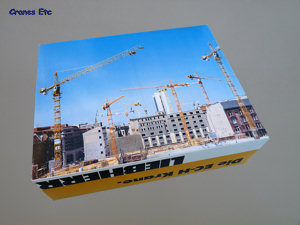 | | The box. |  | 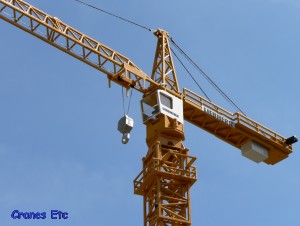 | | Pendant wires on the review model have been replaced with string. | 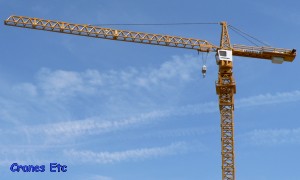 | | Ready for action. |
| The Liebherr EC-H Tower Crane scale model has been available for a number of years. To see photos of the real machine click here.
Packaging
The box for this model is the usual Liebherr style picture sleeve binding together two expanded polystyrene trays. The review model was undamaged.
Detail
The base section is fitted with plastic bogies and has upstanding pins on to which the four solid heavy ballast blocks fit, and steady the model. The casting of the ballast is simple with no delineation to indicate separate concrete slabs.
The mast sections join together by pushing together the sections which have tiny pins included. This system works well but it can be difficult to join the sections if they are not lined up properly. Mast detail is good although one section of the model actually comprises of four sections of the real mast. When joining the mast sections the orientation is important for realism as the lattice work differs on the various sides. The side with the sideways 'K' struts should be on the side of the hydraulic ram of the climbing frame (this is not mentioned in the instructions). There are no plastic ladders as in some other tower crane models of this scale. A capacity board clips on to the bottom of the mast.
The climbing frame is permanently attached to the cab section. Although the climbing frame looks alright, the walkways do not seem quite wide enough and the table for sliding in the mast section looks too high up the frame such that a scale mast section could not be slid in. The cab itself looks good including a seat for the driver and lacks only an internal structural element in the side windows.
The counterweight jib has some basic detail with an electric equipment cabinet and hoist motor. Underneath there is a good lattice frame. The counterweight is a solid block which has grooving to give the appearance of a number of separate slabs, but is perhaps a little small. The main jib comes in two sections and joins well to produce a straight jib. As on all early models, in cross section only two sides of the jib are cast with the underside being hollow. The trolley is plastic with tiny plastic pulleys. The jib pendants consist of pre-bent wire which works but replacing these with strings and tied hooks at each end is preferable and permits the model to be taken down and reassembled any number of times.
As on other early tower crane models the hook block is the worst feature consisting of an oversize hook and no attempt to model a pulley - just an eyelet to feed the hoist rope through.
Features
The hoist can be operated and is controlled by Conrad's typical plastic winding handle. The trolley can be slid along the jib manually. The model rotates well.
Quality
The casting, paintwork and lettering is all good and there is relatively little plastic used.
Price
The model is fair value, but not as good as more modern models.
Overall
The crane looks good and can be posed in a variety of different heights with the mast sections provided. It just cries out for a better scale hook.
Footnotes
The model was introduced before 1993. Earlier versions had an all yellow cab which was changed to white in later versions. In 2004 model 2020 was updated and renumbered as model 2024. It has a modern cab design and interlocking jib pendants which are an improvement on the pre-bent wires of the older version. There were no other improvements.
|
| |
| 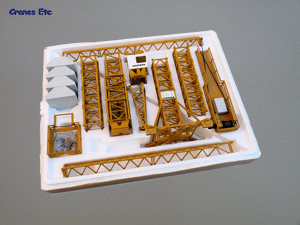 | | The parts in the tray. | 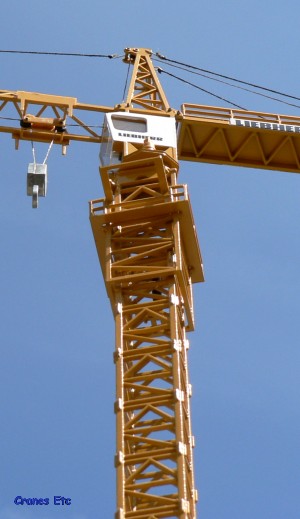 | | The model is convincing when seen from a 'real machine' viewpoint. |
|

